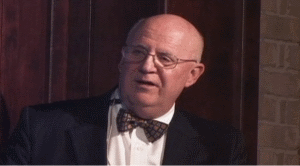Here Mark Lanier asks Edward “How he met and courted Sara Faye?”
Archives for 2014
A Lecture With Dr. Edward Fudge – The Fire That Consumes
This is from The Lanier Library Lecture Series titled The Fire That Consumes: A Biblical and Historical Study of the Doctrine of Final Punishment by Edward Fudge given Sep 24, 2011. The lecture was limited to 800 persons and was closed off several weeks beforehand. It was attended by a broad spectrum of folks on this issue yet the lecture was warmly received by all.
Around the world today, evangelical Bible scholars are giving hell a serious second look. Would the God who gave his Son to die for sinners finally keep billions of them alive forever to torment them without end? Does Holy Scripture require such a conclusion—or offer a different vision? The story of how the great majority of Christians came to teach unending conscious torment is as fascinating as any mystery or “Who-done-it.” In this lecture, Edward Fudge will identify scores of generally-overlooked Scriptures, then lead a tour through some paths of church history that are less well travelled, and which are haunted by pagan philosophy, medieval law and Reformation politics.
Edward Fudge – Are back-to-the-Bible “restoration movements” themselves biblical?
Are back-to-the-Bible “restoration movements” the way of the future in a post-denominational world? Edward Fudge shares biblical insights with The Christian Gospel Temple in Cross Plains, Tenn. (now “New Life Fellowship”) on 08/19/2012.
Origin of Traditional Hell
Edward Fudge presented material from his book The Fire That Consumes.
Proof Texts for Eternal Torment
Edward Fudge presented material from his book The Fire That Consumes.
The Wages of Sin is Death
Edward Fudge presented material from his book The Fire That Consumes.
The Question of Hell and Eternal Punishment
Dr. Brown speaks with Edward Fudge, the author of The Fire that Consumes and an advocate of conditional immortality — meaning, only believers live forever, while the unsaved are destroyed.
WARNING: CONSUMING FIRE
We have just considered the contrast, in Hebrews chapter 12, between Law and Gospel — under the figure of two mountains, Sinai and Zion. The gospel brings us to Mount Zion. It is not a place of fright, terror and dread, but rather of fulfillment and celebration, the fulfillment of all dreams and aspirations. But wait. God is no domesticated deity, either. He is not at our disposal, in need of our services, incomplete without our company, indifferent to our rejection.
“See to it that you do not refuse him who is speaking” (Heb. 12:25). If those who rejected God’s voice from earthly Sinai suffered terribly punishment, what fate must await those who reject God’s voice from Heaven itself? (v. 25). The divine voice at Sinai shook the earth (which nevertheless remained after the incident). The heavenly Voice will thunder once again at the End, quaking the entire universe, leaving nothing of the present created order in its wake, but only the eternal, permanent Kingdom of God (v. 26-28).
We are privileged to participate in this permanent Kingdom — God’s very priests, offering spiritual sacrifice with appropriate reverence and awe (v. 28). But remember: our God of salvation and mercy and redemption — when spurned and rejected throughout life — is finally a consuming fire (v.29; quoting Deut. 4:24).
MOUNT ZION — GOSPEL
Mount Sinai represented Law, but Mount Zion represents Gospel. As believers in Christ, says the author of Hebrews in 12:22-24, we have come to:
* Mount Zion — the joy of believing Israel, the place of God’s Presence, the location of inspiration, blessing and peace (many Psalms).
* The city of the Living God (which, unlike Sinai, cannot be touched) is the Heavenly Jerusalem, inhabited by tens of thousands of angels, the general assembly (literally, “panegyeric” — a FESTIVE assembly where orations are made and worthy people honored (remember chapter 11?).
* The “church” (literally “assembly,” ekklesia — in the Greek Old Testament, the People of God in assembly; in the secular Greek world, a town meeting, Acts 19:30-39) of the firstborn ones who are enrolled as citizens of heaven (see 11:9-10, 12-16, 38-40; see also Book of Life = “Book of Living Citizens” in Revelation).
* God — the universal Judge, which in the Bible usually means VINDICATION for God’s people and PUNISHMENT for their enemies.
* The spirits of righteous people made perfect (“the communion of saints”).
* Jesus — our better-arrangement Mediator — whose blood, like Abel’s, cries out a message, but unlike Abel’s, which calls out for FORGIVENESS rather than for VENGEANCE.
MOUNT SINAI — LAW
Hebrews 12:18-29 provides a great comparison and contrast between Mount Sinai and Mount Zion — two mountains which represent Law and Gospel, Moses and Christ. Both mountains are “awful” in the original sense of that word — inspiring awe in the beholder. That they have in common. But how different they are, as well!
The author’s description of Mount Sinai is taken from Exodus 19-20 in the Old Testament. Moses brought the people to Mount Sinai, which shook and bellowed out smoke deep and dark. Then Moses went up into the mountain alone, to receive the Law from God himself — symbolized in the Ten Commandments written on two stone tablets. This is what it is like to approach God on the basis of our own law-keeping, says the author of Hebrews.
Mount Sinai is physical and earthly (“may be touched” – v. 18). It is foreboding and even terrifying (blazing fire, darkness, gloom, whirlwind, blast of trumpet, sound of words which sent cringing hearers begging to hear no more – v. 18-19), indeed, life-threatening (v. 20-21). Mount Sinai’s portrayal of God is as the Untouchable, the Unapproachable, the Terrible, the Dangerous. To such a scenario, believers in Jesus have not come — although we sometimes behave, and reason, and preach as if we had.


